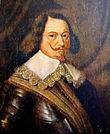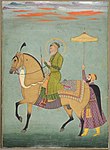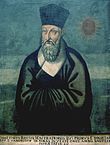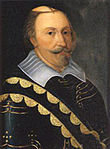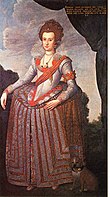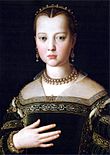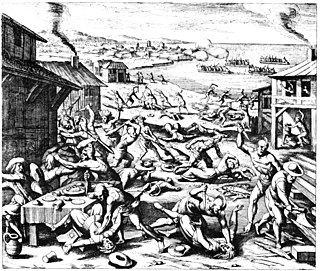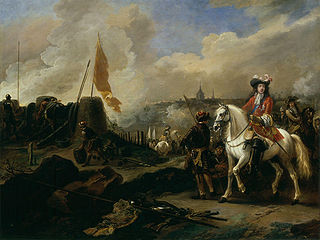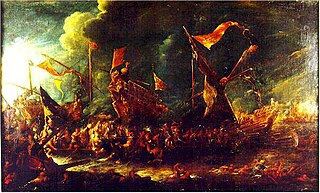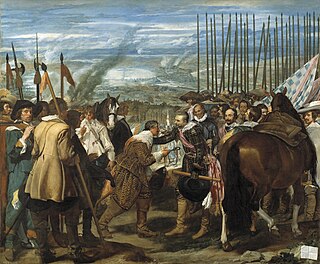Events
1610

January–March
- January 6 – Nossa Senhora da Graça incident: A Portuguese carrack sinks near Nagasaki, after fighting Japanese samurai for four nights.
- January 7 – Galileo Galilei first observes the four Galilean moons of Jupiter: Ganymede, Callisto, Europa and Io, but is unable to distinguish the latter two until the following day.
- February 24 – English courtier Thomas Roe sets out on an expedition to The Guianas and Amazon River.
- March 13 – Galileo Galilei's treatise on astronomy, Sidereus Nuncius , the first printed scientific record of observations through a telescope, is first published. [1]
- March 22 (March 12 O.S.) – Mikhail Skopin-Shuisky, nephew of the Tsar Vasili, liberates Moscow from rebels. [2] [3]
April–June
- April 10 – The Treaty of Brussol is signed between Charles Emmanuel I, Duke of Savoy, and a representative of King Henry IV of France, at a meeting at Bruzolo near Turin. The agreement for France and Savoy to remove Spanish occupiers from Italy, is never carried out because King Henry is assassinated one month later.
- April 20 – William Shakespeare's play, The Tragedie of Macbeth , is given its first performance, staged at the Globe Theatre in London. [4]
- May 13 – A formal coronation is held for Marie de' Medici, wife of King Henry IV, as Queen Consort of France. King Henry is preparing to depart to Germany to participate in the War of the Jülich Succession.
- May 14 – King Henry IV of France is assassinated in Paris by François Ravaillac, a French Catholic activist who resents the Protestant monarch's decision to launch a war against the Catholic Spanish Netherlands. Ravaillac rushes up to a horse-drawn carriage and stabs King Henry in the chest. Henry's 8-year-old son becomes King Louis XIII, with Henry's widow, Marie de' Medici, governing France as queen regent.
- May 23 – Jamestown, Virginia: Acting as temporary Governor, Thomas Gates, along with John Rolfe, Captain Ralph Hamor, Sir George Somers, and other survivors from the Sea Venture (wrecked at Bermuda) arrive at Jamestown; they find that 60 have survived the "starving time" (winter), the fort palisades and gates have been torn down, and empty houses have been used for firewood, in fear of attacks by natives outside the fort area.
- May 24 – Jamestown, Virginia: The temporary Governor, Thomas Gates, issues The Divine, Moral, and Martial Laws.
- May 27 – Regicide François Ravaillac is executed by being pulled apart by horses in the Place de Grève, Paris.
- June 5 – The masque Tethys' Festival is performed at Whitehall Palace to celebrate the investiture of Henry Frederick, Prince of Wales. [5]
- June 7 – Jamestown: Temporary Governor Gates decides to abandon Jamestown.
- June 8 – Jamestown: Temporary Governor Gates' convoy meets the ships of Governor Thomas West, 3rd Baron De La Warr ( Delaware ) at Mulberry Island.
- June 10 – Jamestown: The convoy of temporary Governor Gates, and the ships of Governor Lord De La Warr, land at Jamestown.
July–September
- July 4 – (June 24 O.S.); Polish–Muscovite War – Battle of Klushino: The outnumbered forces of the Polish–Lithuanian Commonwealth defeat the combined Russian and Swedish armies; Polish troops go on to occupy Moscow. [6]
- July 5 – John Guy sets sail from Bristol, with 39 other colonists, for Newfoundland.
- July 9 – Lady Arbella Stuart, a claimant to the throne of England, is imprisoned for clandestinely marrying William Seymour, 2nd Duke of Somerset, another claimant, without royal permission on June 22. [7]
- July 27 (July 17 O.S.) – Vasili Ivanovich Shuisky, who proclaimed himself Tsar of Russia on May 19, 1606, is deposed as the Seven Boyars remove him from office to select a new ruler.
- July 28 – War of the Jülich Succession: The Siege of Jülich, a walled city within the Holy Roman Empire (now in Germany), is started by a combined force of troops from the Dutch Republic, the Kingdom of France and the Margraviate of Brandenburg.
- August 2 – Henry Hudson sails into what is now known as Hudson Bay, thinking he has made it through the Northwest Passage and reached the Pacific Ocean.
- August 9 – Anglo-Powhatan Wars: The English launch a major attack on the Paspahegh village, capturing and executing the native queen and her children, burning houses and chopping down the corn fields; the subsequent use of the term "Paspahegh" in documents refers to their former territory.
- September 1 – Claudio Monteverdi's musical work Vespro della Beata Vergine ( Vespers for the Blessed Virgin ) is first published, printed in Venice and dedicated to Pope Paul V.
- September 2 – The Siege of Jülich ends as the Holy Roman Imperial city surrenders to Maurice of Nassau, commander of the Dutch Republic troops.
- September 4 – The Kingdom of Toungoo (now Myanmar) is retaken by King Anaukpetlun of Burma, as rebel leader Natshinnaung surrenders the city of Taungoo.
- September 6 – (August 27 O.S.); The Seven Boyars, the group of seven Russian nobles seeking stability in the troubled nation, vote to have King Wladyslaw IV of Poland as Tsar Vladislav of Russia, and invite the Polish-Lithuanian Commonwealth to take over the city.
- September 19 – Frederick V, age 14, becomes the new Prince-Elector of the Rhineland Palatinate, two days after the death of his father, Frederick IV.
- September 21 (September 11 O.S.) – Forces of the Polish-Lithuanian Commonwealth capture Moscow and begin occupation of the Kremlin for the next two years.
October–December
- October 9 – Poland, under the command of Hetman Stanisław Żółkiewski, takes control of the Kremlin during the Polish–Muscovite War.
- October 17 – The coronation of Louis XIII of France takes place. [8]
- October 24 – The War of the Jülich Succession ends as the Protestant Union (including Margraviate of Brandenburg Brandenburg and Electoral Palatinate) and the Catholic League (led by the Duchy of Bavaria) agree to withdraw their forces from Germany and to disband them by year's end.
- November 6 – After the Parliament of England gives King James only £ 100,000 of an agreed to £ 600,000 of debt relief promised in February under the Great Contract, the King demands the rest of the funds. Parliament is outraged and declares the Contract abandoned on November 9.
- November 8 – The Basque witch trials come to an end after almost two years. Out of about 7,000 persons accused of witchcraft, only six are condemned to be executed by the Spanish Inquisition as two men (Domingo de Subildegui and Petri de Joangorena) and four women (María de Echachute, Graciana Xarra, Maria Baztan de Borda, and Maria de Arburu) are burned at the stake at Logroño . [9]
- November 20 – The cession of Larache, a port in Morocco, takes place as Mohammed esh Sheikh el Mamun, Sultan of Morocco, transfers control of the city to Spain in return for. The Marquis de la Hinojosa accepts on behalf of King Felipe III of Spain in return for Spain's aid to the Sultan's fight against the Sultan's brother, Zidan Abu Maali. Larache remains under Spanish control for the next 79 years until another sultan retakes it. [10]
- November 26 – French astronomers Nicolas-Claude Fabri de Peiresc and Joseph Gaultier make the first detailed observations of the Orion Nebula.
- December 18 – (December 8 O.S.) English astronomer Thomas Harriot becomes the first person on Earth to observe sunspots through a telescope. [11]
- December 19 – Pieter Both becomes the first Governor-general of the Dutch East Indies (now the Republic of Indonesia), serving until 1614.
- December 20 – (December 10 O.S.), John Roberts, a Benedictine monk in Wales, is executed five days after being convicted of high treason for violating a law against Catholic ministry. He is hanged, drawn and quartered. Roberts will be canonized as a Roman Catholic saint almost 360 years later, on October 25, 1970.
- December 21 – (December 11 O.S.) The second False Dmitry is assassinated by a Kasim Tatar prince, Peter Urusov. After both Dmitry and Urosov have been drinking, Urusov shoots the Tsar Dmitry, then decapitates him. [12]
Date unknown
- Dr. Bonham's Case, a landmark decision, is decided by Edward Coke, Chief Justice of the Common Pleas of England. Coke affirms the supremacy of the common law, which limits the power of Parliament as well as the king. [13]
- The Manchu tribal leader Nurhaci breaks his relations with the Ming dynasty of China, at this time under the aloof and growingly negligent Wanli Emperor; Nurhaci's line later becomes the emperors of the Qing dynasty, which overthrows the short-lived Shun dynasty in 1644, and the remnants of the Ming throne in 1662.
- Publication is completed of the Douay–Rheims Bible (The Holie Bible Faithfully Translated into English), a translation of the Bible from the Latin Vulgate into English made by members of the English College, Douai, in the service of the Catholic Church. [14]
- Jakob Böhme experiences another inner vision, in which he believes that he further understands the unity of the cosmos, and that he has received a special vocation from God.
- Work starts on the Wignacourt Aqueduct, in Malta.
- Santa Fe, New Mexico, capital of New Mexico, is founded as capital of Kingdom of Nuevo México. [15]
- Henri Membertou, Grand Chief of Mi'kmaq nation signs Concordat of 1610, an agreement with the Roman Catholic Church recognizing the Mi'kmaq as an independent nation.
1611
January–March
- January 26 – Maximilien de Béthune, Duke of Sully is forced by Queen regent Marie's Regency Council to resign as chief minister of France. [16] He is replaced by Nicolas de Neufville, seigneur de Villeroy.
- February 27 – Sunspots are observed by telescope, by Frisian astronomers Johannes Fabricius and David Fabricius. Johannes publishes the results of these observations, in De Maculis in Sole observatis in Wittenberg, later this year. [17] Such early discoveries are overlooked, however, and the first sighting is claimed a few months later, by Galileo Galilei and Christoph Scheiner.
- March 4 – George Abbot is enthroned as Archbishop of Canterbury in England. [18]
- March 9 – Battle of Segaba in Begemder: Yemana Kristos, brother of Emperor of Ethiopia Susenyos I, ends the rebellion of Melka Sedeq.
- March 19–20 – The Moscow Uprising, an armed rising of the inhabitants of Moscow in the Tsardom of Russia against the military Polish–Lithuanian occupation of Moscow (Fall 1610–Fall 1612), results in the occupying forces starting a major fire in the city and the death of 6–7,000 Muscovites. [19]
April–June
- April 4 – Denmark-Norway declares war on Sweden, then captures Kalmar.
- April 7 (March 28 O.S.) – False Dmitry III, the third pretender to the Russian throne to claim to be Prince Dmitry of Uglich, son of Ivan the Terrible, arrives at Ivangorod and proclaims himself as the Tsar Dmitry Ivanovich I.
- April 28 – The Colegio de Nuestra Señora del Santísimo Rosario is established in Manila, the Philippines (later renamed Colegio de Santo Tomas, and later still the University of Santo Tomas). [20]
- April 30 – The priest implicated in the Aix-en-Provence possessions in France is executed.
- May 2 – The Authorized King James Version of the Bible is published for the first time, printed by Robert Barker in London.
- May 9 – At the age of 16, Emperor Go-Mizunoo succeeds his father Emperor Go-Yōzei as Emperor of Japan.
- May 11 – The first known performance of William Shakespeare's The Winter's Tale , probably new this year, is given at the Globe Theatre in London. [21]
- May–December – Entrepreneur Thomas Sutton founds Charterhouse School, on the site of the old Carthusian monastery in Charterhouse Square, Smithfield, London.
- June 13 – The Siege of Smolensk in Russia by the Polish-Lithuanian Commonwealth succeeds after nearly two years of fighting that started on 29 September 1609. The conquest of the city is made possible by the discovery of a weakness in the walls of the fortress and the detonating of an explosive in a drainage canal.

- June 22 – English explorer and sea captain Henry Hudson, his teenage son John, and seven crewmen are set adrift in or near Hudson Bay, after a mutiny on his ship Discovery . They are never seen again.
July–September
- July 12 – The Perpetual Edict is proclaimed for the government of the Southern Netherlands (modern-day Belgium) by Archduke Albert VII and his wife Isabella, the joint rulers of the Austrian-controlled nation.
- July 17 – The army of the Swedish Empire commanded by Jacob De la Gardie captures the Russian city of Novgorod after a nine-day battle. Novgorod will remain Swedish territory for the next eight years.
- August 2 – Jamestown's Deputy Governor Sir Thomas Gates returns to Virginia with 280 people, provisions and cattle on six ships and assumes control, ruling that the fort must be strengthened.
- August 5 – Nasuh Pasha becomes the new grand vizier of the Ottoman Empire after the death of Kuyucu Murad Pasha.
- September 11 – Greek Orthodox bishop Dionysios Skylosophos leads an army of 700 men in a surprise attack on the city of Yanya (formerly the ancient Greek city of Ioannina) in an attempt to liberate the inhabitants from Ottoman Imperial rule. The Ottoman provincial governor, Osman Pasha, is forced to flee and his home is burned down, but Ottoman troops commanded by Aslan Pasha rout the rebels. Skylosophos is captured on September 14, then tortured to death in public.
October–December
- October 30 – At the age of 16, Gustav II Adolf succeeds his father Charles IX as King of Sweden.
- November 1 – At Whitehall Palace in London, William Shakespeare's last solo play, The Tempest , is given its earliest reported performance.
- December 2 (Keichō 16, 10th month, 28th day) – The 1611 Sanriku earthquake of 8.1 magnitude strikes off of the coast of Japan and causes a tsunami that kills almost 5,000 people in the northern section of Honshu island.
- December 5 (30 Ramadan 1020 A.H.) – To celebrate the end of the daily fasting of the month of Ramadan, the Mughal Empire Army commander, Mubariz Khan, hosts the celebration banquet and learns that Pashtun rebel leader Khwaja Usman and 250 of his men have evacuated Bokainagar (modern-day Gouripur in Bangladesh) during the Mughal Army's holiday observance.
- December – The week-long Conquest of Bakla leads to the fall of the Chandradwip kingdom and the Mughal annexation of Barisal into the Bengal Subah
Date unknown
- At Jamestown, John Rolfe imports tobacco seeds from the island of Trinidad ( Nicotiana tabacum ); the native tobacco is Nicotiana rustica .
- Thomas Dale founds the city of Henricus on the James River, with the assistance of 350 men, a few miles south of present day Richmond, Virginia.
- Famine in Ethiopia resulting from crop failure in the north due to weather conditions and the outbreak of a plague.
- Construction begins on Naqsh-e Jahan Square in Isfahan, Persia.
- Itoh Gofuku, a predecessor of Matsuzakaya, a famous department store, is founded for the sale of silk in Nagoya, Japan.
1612
January–March
- January 6 – Axel Oxenstierna becomes Lord High Chancellor of Sweden. He persuades the Riksdag of the Estates to grant the Swedish nobility the right and privilege to hold all higher offices of government.
- January 20
- Rudolf II, Holy Roman Emperor, dies and several candidates vie to succeed him, with Archduke Matthias eventually being elected. [22]
- An uprising led by Dmitry Pozharsky begins in Moscow against occupying Polish troops.
- February 11 – King Gustavus Adolphus of Sweden and 3,000 of his troops are forced to retreat from Denmark troops in the Battle of Vittsjö. The 17-year old king almost drowns while attempting to ride his horse across a frozen lake, but is rescued by two other members of his cavalry. The horse is lost.
- March 2 – The False Dmitry III, one of three pretenders to the Russian throne who all claim to be sons of Ivan the Terrible, is recognized as Tsar of Russia by the Cossacks.
- March 12 – At Daulambapur, near Kamalganj in what is now the Indian state of Uttar Pradesh, a battle takes place between 4,500 troops led by General Islam Khan I of India's Mughal Empire, and 12,000 defenders led by the Afghan warlord Khwaja Usman. The Mughals are almost defeated until Usman is struck in the eye by an arrow fired from a crossbow.
April–June
- April 11 – Edward Wightman, a radical Anabaptist, becomes the last person to be executed for heresy in England, by burning at the stake in Lichfield. [22]
- May 10 – Shah Jahan marries Mumtaz Mahal. [23]
- May 25 – A Sicilian–Neapolitan galley fleet defeats the Tunisians at La Goulette after a battle of two days.
- June 13 – Archduke Matthias of Austria is formally elected as the new Holy Roman Emperor. [22]
July–September
- July 22 – Four women and one man are hanged following the Northamptonshire witch trials in England.
- August 20 – Ten Pendle witches are hanged, having been found guilty of practising witchcraft in Lancashire in England.
- August 26 – Battle of Kringen: A Scottish mercenary force is destroyed in Norway.
- September 1 – Battle of Moscow (1612): Led by General Jan Karol Chodkiewicz, a relief force from the Polish-Lithuanian Commonwealth, whose troops had been occupying Moscow for two years, make an unsuccessful attempt to break the Russian siege of the Kremlin, where General Mikolaj Strus and his troops are trapped. Both the Russians (led by Dmitry Pozharsky) and the Commonwealth troops suffer at least 1,000 deaths, but the Russians prevail. General Chodkiewicz tries a second attack the next day and fails.
- September 2 (August 23 O.S.) – The Lutheran Duchy of Prussia, a fiefdom within Poland, becomes the first Protestant government to follow the Roman Catholic nations in adopting the Gregorian calendar.
- September 5 – England's East India Company gets its first warships and establishes the "'Honourable East India Company's Marine'" to protect its freighters. The force develops over the centuries into the Royal Indian Navy and, after India's independence in 1947, the Indian Navy.
- September 22 – Retreating Polish and Lithuanian troops burn the Russian city of Vologda in reprisal for their defeat at Moscow.
October–December
- October 27 – Forces of the Polish-Lithuanian Commonwealth, which had been occupying Moscow for more than two years, surrender unconditionally to Russian militia forces and are allowed to leave. [24]
- November 29 – The Treaty of Nasuh Pasha is signed, between the Ottoman Empire and the Safavid Empire.
- November 30 – Battle of Swally: Forces of the English East India Company and Portugal engage off the coast of India, resulting in an English victory. [25]
- December 15 – Simon Marius becomes the first person on Earth to observe the Andromeda Galaxy through a telescope.
- December 28 – Galileo Galilei becomes the first astronomer to observe the planet Neptune when in conjunction with Jupiter. He mistakenly catalogues it as a fixed star, because of its extremely slow motion along the ecliptic. Neptune will not be truly recognized as a planet until 1846, about 234 years later, when Johann Gottfried Galle first sights it in the Berlin Observatory.
Date unknown
- The Nagoya Castle is completed in Japan.
- The Okamoto Daihachi incident in Japan.
- Thomas Shelton's English translation of the first half of Don Quixote is published. It is the first translation of the Spanish novel into any language.
1613
January–March
- January 11 – Workers in a sandpit in the Dauphiné region of France discover the skeleton of what is alleged to be a 30-foot tall man (the remains, it is supposed, of the giant Teutobochus, a legendary Gallic king who fought the Romans). [26]
- January 20 – King James I of England successfully mediates the Treaty of Knäred between Denmark and Sweden. [27]
- February 14 – Elizabeth, daughter of King James I of England, marries Frederick V, Elector Palatine. [28]
- February 24 – King Anaukpetlun of Burma blockades the Portuguese port at Syriam with 80 warships and 3,000 men, then sets about to tunnel into the city.
- March 3 (February 21 O.S.) – An assembly of the Russian Empire elects Mikhail Romanov Tsar of Russia, ending the Time of Troubles. The House of Romanov will remain a ruling dynasty until 1917.
- March 27 – The first English child is born in Canada at Cuper's Cove, Newfoundland to Nicholas Guy.
- March 29
- Explorer Samuel de Champlain becomes the first unofficial Governor of New France in Canada.
- Burmese soldiers, tunneling under the walls of the Portuguese colonial fortress at Syriam (now Thanlyin), bring down a section of the walls and sack the city. Portuguese Governor Filipe de Brito e Nicote and rebel Burmese General Natshinnaung are captured, and executed by impalement on April 9.
April–June
- April 13 – Samuel Argall captures Algonquian princess Pocahontas in Passapatanzy, Virginia, to ransom her for some English prisoners held by her father, Chief Powhatan. She is brought to Henricus as a hostage. [29]
- May 12 – Mikhail Romanov arrives in Moscow to begin his reign as Tsar of Russia, after having been elected on March 3.
- May 14
- The city of Hanthawaddy (now Bago) is restored as the capital of Burma by King Anaukpetlun, who relocates the government from Ava (now Inwa).
- The ruler of the principality of Martaban, Binnya Dala, surrenders to the armies of King Anaukpetlun of Burma.
- May 23 – War of the Montferrat Succession: The defenders of the Italian city of Nizza Monferrato successfully resist a nine-day siege by the troops of Charles Emmanuel I, Duke of Savoy.
- May 27 – After getting an official proclamation that he is the French Governor of New France, explorer Samuel de Champlain begins exploration of the area westward from Quebec, traveling along the Ottawa River.
- June 28 (July 8 N.S.) – From Jamestown, John Rolfe makes the first shipment to England of tobacco grown in Virginia, dispatching it on the ship The Elizabeth. [30] The tobacco arrives in England after a voyage of three weeks.
- June 29 – Fire destroys London's famed Globe Theatre, during a performance of Shakespeare's Henry VIII. [31]
July–September
- July 20 (July 30 N.S.) – The first American-grown tobacco, produced in the British colony of Virginia, arrives in England after being dispatched 22 days earlier by John Rolfe. [30]
- July 28 – Gregor Richter, the chief pastor of Görlitz, denounces Jacob Boehme as a heretic, in his Sunday sermon.
- August 29 – The Sicilians under de Aragon defeat the trade fleet of the Ottoman Empire, ending the Battle of Cape Corvo.
- September 29 – The New River is opened, to supply London with drinking water from Hertfordshire.
October–December
- October 28 – Keichō embassy: Hasekura Tsunenaga sets out in the Date Maru with a Japanese diplomatic mission to the Holy See, first traveling to Acapulco in New Spain; this follows soon after an agreement between Tokugawa Ieyasu and the East India Company, permitting English merchants to live and trade in Japan.
- November 3 – English royal favourite Robert Carr is created 1st Earl of Somerset.
- December 26 – The Earl of Somerset marries Frances Howard, following her divorce from Robert Devereux, 3rd Earl of Essex; the event is the inspiration for John Donne's Eclogue. [32]
Date unknown
- A locust swarm destroys La Camarque, France.
- Kuwait City is founded.
- Sultan Agung of Mataram takes the throne of the kingdom of Mataram in Java.
- Near Jamestown, Virginia, Sir Thomas Dale starts a settlement called Bermuda City, which later becomes part of Hopewell, Virginia.
1614

January–March
- January 22 – Led by Hasekura Tsunenaga, Japan's trade expedition to New Spain (now Mexico) arrives on the Mexican coast with 22 samurai, 120 Japanese merchants, sailors and servants, and 40 Spaniards and Portuguese who serve as interpreters. [33] Having reached the Americas after a voyage that began on October 28, the expedition travels to Acapulco and arrives on January 25.
- January 27 – The Noordsche Compagnie is founded in the Netherlands at Vlieland as a cartel in the whaling market.
- February 2 – Iran's Safavid dynasty Emperor, Abbas the Great, carries out the execution of his oldest son, Crown Prince Mohammad Baqer Mirza, on suspicion that his son is planning to kill him. [34]
- February 14 (February 4 O.S.) – King James I of England issues his proclamation Against Private Challenges and Combats in an effort to end duels.
- February 20 – Matthias I, Archduke of Austria, King of Hungary, Croatia and Bohemia, and Holy Roman Emperor, directs the restoration of Roman Catholic rule to Aachen, allowing the Army of Flanders (from the Spanish Netherlands) to lay siege to the German town.
- March 15 – Construction begins on the Takada Castle in Japan.
- March 17 – The States General of the Republic of the Seven United Netherlands authorizes an exclusive monopoly for trade in the New World, providing for the winning company to be able to make four voyages to the eastern coast of North America between 40° N and 45° N, encompassing what are now the U.S. states of New Jersey. The New Netherland Company receives the exclusive patent, effective January 1, 1615.
April–June
- April 5 (April 15 N.S.)
- Pocahontas, the 17-year-old daughter of Chief Wahunsenacawh of the Powhatan Algonquian native tribe in what is now the U.S. state of Virginia, is forced into child marriage with English colonist John Rolfe at Jamestown, a year after her capture in war. She is given the name of Rebecca Rolfe and departs with John Rolfe to England in 1616, dying before she can return.
- The Addled Parliament is assembled in England as the second parliament of King James I, and the first in more than nine years. Its members serve for two months without passing any laws.
- The Republic of the Netherlands and the Kingdom of Sweden enter into a treaty at the Hague. A new parliament will not be seated until more than six years later.
- April 30 – The Kingdom of Lan Na (in what is now northern Thailand) is invaded by 17,000 troops commanded by King Anaukpetlun of Burma (now Myanmar). Lan Na's King Thado Kyaw is unsuccessful in getting assistance from the Kingdom of Siam, and turns to the Kingdom of Lan Xang (now Laos), which provides assistance.
- May 14 – An earthquake strikes the Azores islands and levels the village of Vila Franca do Campo.
- May 15 – The Queen Regent of France, Marie de' Medici, convenes the Estates General to suppress a rebellion by Henri II, Prince of Condé.
- May 17 – Mutinous "konfederacja" Polish troops are defeated at the Battle of Rohatyn by the Polish Army, led by General Stanisław Koniecpolski.
- June 7 – The Addled Parliament is dissolved by King James.
July–September
- July 6 – Raid of Żejtun: Ottoman forces make a final attempt to conquer the island of Malta, but are beaten back by the Knights Hospitaller.
- July 16 – In reprisal for the attempt of "the False Dmitry", a man who claimed to be the son of Ivan the Terrible, to claim the throne, Tsar Michael I has Dmitry's 3-year-old son, Ivan Dmitriyevich, publicly hanged in Moscow.
- August 23 – The University of Groningen is established in the Dutch Republic. [35]
- August 24 – The Siege of Aachen begins as the Spanish Army of Flanders, commanded by Amrogio Spinola, attacks with 15,000 troops. The 600-man defense force from Brandenburg surrenders a few days later.
- September 1 – In England, Sir Julius Caesar becomes Master of the Rolls.
October–December
- October 2 – After Louis XIII reaches the age of 23, he is given full power as King of France and the regency of his mother is ended. Queen Regent Marie retains her position as leader of the Conseil du Roi, however, and continues to control the French government.
- October 11 – Adriaen Block and a group of Amsterdam merchants petition the States General of the Northern Netherlands for exclusive trading rights, in the area he explored and named "New Netherland".
- October 13 – The second War of the Jülich Succession, which flared up a second time in May, comes to an end.
- October 17 – On the orders of Ahmed I, Sultan of the Ottoman Empire, Grand Vizier Nasuh Pasha is strangled to death by the chief of the Sultan's bodyguards.
- November 12 – The Treaty of Xanten ends the War of the Jülich Succession. [36]
- November 19 – Hostilities resulting from an attempt by Toyotomi Hideyori to restore Osaka Castle begin. Tokugawa Ieyasu, father of the shōgun , is outraged at this act, and leads three thousand men across the Kizu River, destroying the fort there.
- December 4 – The Siege of Osaka begins in Japan.
Date unknown
- The French Estates General meets for the last time prior to 1789 (the outbreak of the French Revolution). In the interim, the Kingdom of France will be governed as an absolute monarchy.
- Scottish mathematician John Napier publishes Mirifici Logarithmorum Canonis Descriptio (Description of the Admirable Table of Logarithms), outlining his discovery of logarithms, and incorporating the decimal mark. Astronomer Johannes Kepler soon begins to employ logarithms, in his description of the Solar System.
- Tisquantum, [37] a Native American of the Wampanoag Nation, is kidnapped and enslaved by Thomas Hunt, an English sea captain working with Captain John Smith. Freed in Spain, Tisquantum (a.k.a. Squanto) will travel for five years in Europe and North America, before returning to his home in Plymouth, Massachusetts. Twenty months later, he will be able to teach the Pilgrims [38] the basics of farming and trade in the New World.
- The Fama Fraternitatis is published, the first of three allegorical Rosicrucian manifestoes in the Holy Roman Empire
- Christianity is banned throughout Japan.
- The Duchess of Malfi is performed at the Globe theatre
1615
January–March
- January 1 – The New Netherland Company is granted a three-year monopoly in North American trade, between the 40th and 45th parallels.
- January 30 – Japan's diplomatic mission to Europe, led by Hasekura_Tsunenaga, meets with King Philip III of Spain at Madrid and presents an offer of a treaty.
- February 2 – Sir Thomas Roe sets out to become the first ambassador from the court of the King of England to the Mughal Emperor Jahangir, [39] [40] departing from Tilbury Hope on the ship Lyon under the command of captain Christopher Newport. [41]
- February 17 – Japan's envoy to Europe, Hasekura Tsunenaga, receives a Christian baptism by the royal chaplain, Diego de Guzmán, and receives the European name Felipe Francisco Hasekura. [42]
- March 10 – John Ogilvie, a Jesuit priest, is hanged and drawn at Glasgow Cross in Scotland for refusing to pledge allegiance to King James VI of Scotland; he will be canonised in 1976, becoming the only post-Reformation Scottish saint.
April–June
- April 21 – The Wignacourt Aqueduct is inaugurated in Malta.
- May 6 – The Peace of Tyrnau is signed between Matthias, Holy Roman Emperor, and Gábor Bethlen. [43]
- June 2 – The first Récollet missionaries arrive at Quebec City, from Rouen, France.
- June 3 – The Eastern Army of Tokugawa Ieyasu and the Osaka Army of Toyotomi Hideyori clash during the Battle of Dōmyōji and the Battle of Tennōji.
- June 4 – Forces under shōgun Tokugawa Ieyasu take Osaka Castle in Japan, beginning a period of peace which lasts nearly 250 years. Bands of Christian samurai support Ieyasu's enemies at the Battle of Osaka.
- June 21 – The Peace of Asti is concluded between the Spanish Empire and Savoy. [44]
July–September
- July 7 – In Japan, the Buke shohatto, a 19-section law setting a standard of conduct for individual warlords (daimyo) and their responsibilities to the Tokugawa shogunate, is proclaimed by the shogun Tokugawa Hidetada before the assembled daimyo at Fushimi Castle in Kyoto. [45]
- August 9 – Swedish troops led by King Gustavus Adolphus begin the siege of the Russian city of Pskov, but fail to take the fortress after 12 weeks. The siege ends on October 27.
- August 20 – Alvaro III Nimi a Mpanzu becomes the new ruler of the Kingdom of Kongo (located in southwestern Africa in what is now Angola) upon the death of his brother, Bernardo II Nimi a Nkanga.
- August 30 – A Spanish treasure fleet of 41 ships is struck in the Gulf of Mexico by a powerful storm that sinks the ship San Miguel
- September 12 – The San Leoncio Day hurricane strikes the islands of Puerto Rico and Hispaniola.
- September 16 – An estimated 7.5 magnitude earthquake strikes Arica (now part of Chile in the Spanish colonial Viceroyalty of Peru and collapses the city's fort, but causes no deaths.
- September 17 – Los Baños, Laguna, is founded by Spanish colonists on Luzon island in the Philippines.
- September 20 – Japanese diplomat Hasekura Tsunenaga and his entourage become the first officials from Japan to visit Italy, and are received in Rome by Cardinal Burgecio
October–December
- October 5 – The Spánverjavígin, the last massacre to be carried out in Iceland, begins as 14 Basque Whalers from Spain are murdered at Thingeyri while sleeping. Another 18 are killed on October 13, including Captain Martín de Villafranca. The 31 had been survivors of a shipwreck on Iceland in September.
- October 27 – In Russia, the siege of Pskov ends with the withdrawal of Swedish Army troops. The siege is the last battle of the Ingrian War.
- November 3 – Japanese diplomat Hasekura Tsunenaga and his delegation are received by Pope Paul V in Rome, and present a request for trade between the Roman Catholic Church and the Japanese Empire. [46]
- November 7 – The Portuguese freighter Nossa Senhora da Luz, carrying 150 crew and a cargo of Chinese and Burmese goods, sinks in a storm near the Azores.
- November 22 – Alexandru Movilă is installed as Prince of Moldavia by Poland as Prince Ștefan IX Tomșa is driven from the throne.
- November 24 – King Louis XIII of France marries Princess Ana María Mauricia, the 14-year-old daughter of King Philip III of Spain. The two had been legally united in a marriage by proxy on October 18.
- November – The Mughals under Jahangir launch the first offensive against Kajali, a border post of the Ahom kingdom.
- December 2 – In the Venetian Republic, Giovanni Bembo is elected chief executive as the new Doge of Venice after the October 31 death of Marcantonio Memmo.
- December 6 – In England, John Winthrop, later governor of the future Massachusetts Bay Colony, marries his second wife (of four), Thomasine Clopton, daughter of William Clopton of Castleins, near Groton, Suffolk.
- December 18 – Francisco de Borja y Aragón becomes the new Viceroy of Peru, a colony of Spain encompassing all of Spanish language-speaking South America and what are now the nations of Peru, Argentina, Bolivia, Chile, Colombia, Ecuador, Panama, Paraguay, and Uruguay.
- December 20 – The Uskok War begins after the ports of the Holy Roman Empire on the Adriatic Sea are blockaded by the Republic of Venice, which has hired English and Dutch mercenaries.
Date unknown
- Easter – Persian Safavid hordes, led by Shah Abbas the Great, kill all the monks at the David Gareja monastery complex in Georgia, and set fire to its collection of manuscripts and works of art.
- Mary Talbot, Countess of Shrewsbury, is released from the Tower of London, in recognition of her role in helping to discover the murder of Sir Thomas Overbury.
- The Somers Isles Company is founded to administer Bermuda.
- John Browne is created the first King's Gunfounder in England.
- Austrian merchants receive economic privileges in the Ottoman Empire.
- The Perse School in Cambridge, England, is founded by Dr Stephen Perse.
- Wilson's School in Wallington, near London, is founded by Royal Charter.
- The Grolsch Brewery is founded in Groenlo, Netherlands.
- Konoike Shinroku opens an office in Osaka, and begins shipping tax-rice from western Japan to Osaka.
- Johannes Kepler publishes Dissertatio cum Nuncio Sidereo, in response to Galileo's discovery of Jupiter's moons. [47]
- Manuel Dias, a Portuguese Jesuit missionary, introduces the telescope for the first time in China, in his book Tian Wen Lüe (Explicatio Sphaerae Coelestis).
- The second volume of Miguel de Cervantes's Don Quixote ("El ingenioso hidalgo Don Quijote de la Mancha") is published, and is as successful as the first. Don Quixote eventually becomes the only truly famous work its author ever writes.
1616
January–March
- January 1 – King James I of England attends the masque The Golden Age Restored , a satire by Ben Jonson on fallen court favorite the Earl of Somerset. The king asks for a repeat performance on January 6. [48]
- January 3 – In the court of James I of England, the king's favorite George Villiers becomes Master of the Horse (encouraging development of the thoroughbred horse); on April 24 he receives the Order of the Garter; and on August 27 is created Viscount Villiers and Baron Waddon, receiving a grant of land valued at £80,000. In 1617, he will be made Earl of Buckingham. After the Earl of Pembroke, he is the second richest nobleman in England.
- January 10 – English diplomat Sir Thomas Roe presents his credentials to the Mughal Emperor Jahangir, in Ajmer Fort, opening the door to the British presence in India. [49] [50] Roe sailed in the Lyon under the command of captain Christopher Newport, best known for his role in the Virginia colonies.
- January 12 – The city of Belém, Brazil is founded on the Amazon River delta, by Portuguese captain Francisco Caldeira Castelo Branco, who had previously taken the city of São Luís in Maranhão from the French.
- January 15 – After overwintering with the Huron Indians, Samuel de Champlain and Recollect Father Joseph Le Caron visit the Petun and Ottawa Indians of the Great Lakes. This is Champlain's last trip in North America before returning to France. Having secured Canada, he helps create French America, New France, or L'Acadie.
- January 29 – Dutch captain Willem Schouten, in the Eendracht, rounds the southern tip of South America, and names it Kaap Hoorn, after his birthplace in Holland.
- January – 6-year-old António Vieira arrives from Portugal with his parents in Bahia (modern-day Salvador) in Colonial Brazil, where he will become a diplomat, noted author, leading figure of the Church, and protector of Brazilian indigenous peoples, in an age of intolerance.
- February 1 – James I of England grants Ben Jonson an annual pension of 100 marks, making him de facto poet laureate. [51]
- February 17 – Manchurian leader Qing Tai Zu, referred to in the west as "Nurhaci", declares himself khan and crowns himself as Emperor of China, founding the Qing dynasty.
- February 19 – The first recorded eruption of Mayon Volcano, the Philippines' most active volcano, takes place. [52]
- February 24 – A commission of Roman Catholic theologians, the "Qualifiers," reports that the idea that the Sun is stationary is "foolish and absurd in philosophy, and formally heretical since it explicitly contradicts in many places the sense of Holy Scripture...".
- February 28 – In the aftermath of the 1613–1614 anti-Jewish pogrom called the Fettmilch uprising in Frankfurt, Germany, mob leader Vincenz Fettmilch is beheaded, but the Jews, who had been expelled from the city on August 23, 1614, following the plundering of the Judengasse, can return only as a result of direct intervention by Holy Roman Emperor Matthias. After long negotiations, the Jews are left without any compensation for their plundered belongings.
- February – English merchants of the East India Company complain that the great troubles and wars in Japan since their arrival have put them to much pains and charges. Two great cities, Osaka and Sakaii, have been burned to the ground, each one almost as big as London, and not one house left standing, and it is reported above 300,000 men have lost their lives, “yet the old Emperor Ogusho Same hath prevailed and Fidaia Same either been slain or fled secretly away, that no news is to be heard of him.” Jesuits, priests, and friars are banished by the emperor and their churches and monasteries pulled down; they put the fault on the arrival of the English; it is said if Fidaia Same had prevailed against the emperor, he promised them entrance again, when without doubt all the English would have been driven out of Japan. [53]
- March 5 – Nicolaus Copernicus' De revolutionibus orbium coelestium (1543) is placed on the Index of Forbidden Books, by the Congregation of the Index of the Roman Catholic Church "until corrected".
- March 11
- Galileo Galilei meets Pope Paul V in person, to discuss his position as a defender of Copernicus' heliocentrism.
- English Roman Catholic priest, Thomas Atkinson, is hanged, drawn, and quartered at York, at age 70 (he will be beatified by Pope John Paul II on November 22, 1987).
- March 19
- Sir Walter Ralegh, English explorer of the New World, is released from prison in the Tower of London, where he has been imprisoned for treason, in order to conduct a second (ill-fated) expedition, in search of El Dorado in South America. [54]
- The Scornful Lady, a comedy stage play written by Francis Beaumont and John Fletcher, is published.
- March 26–August 30 – English explorer William Baffin, as pilot to Robert Bylot on the Discovery , makes a detailed exploration of Baffin Bay, whilst searching for the Northwest Passage. [55] The expedition also discovers Smith Sound, Lancaster Sound and Devon Island, and reaches latitude 77° 45' North, a record which holds for 236 years.
- March 31 – Mughal Emperor Jahangir confers the title of Nur Jahan ('Light of the World') on his 20th wife. [56] [57] [58]
- March – Action of 1616, La Goulette, Tunisia: A Spanish squadron under Francisco de Ribera defeats a Tunisian fleet.
April–June
- April 25 – Sir John Coke, in the Court of King's Bench (England), holds the King's actions in a case of In commendam to be illegal.
- May 3 – The Treaty of Loudun is signed, ending a series of rebellions in France. [59]
- May 25 – King James I of England's former favourite, the Earl of Somerset, and his wife Frances, are convicted of the murder of Thomas Overbury in 1613. They are spared death, and are sentenced to imprisonment in the Tower of London (until 1622). [60] Although the King has ordered the investigation of the poet's murder and allowed his former court favorite to be arrested and tried, his court, now under the influence of George Villiers, gains the reputation of being corrupt and vile. The sale of peerages (beginning in July) [61] and the royal visit of James's brother-in-law, Christian IV of Denmark, a notorious drunkard, add further scandal.
- June 12 – Pocahontas (now Rebecca) arrives in England, with her husband, John Rolfe, [62] their one-year-old son, Thomas Rolfe, her half-sister Matachanna (alias Cleopatra) and brother-in-law Tomocomo , the shaman also known as Uttamatomakkin (having set out in May). Ten Powhatan Indians are brought by Sir Thomas Dale, the colonial governor, at the request of the Virginia Company, as a fund-raising device. Dale, having been recalled under criticism, writes A True Relation of the State of Virginia, Left by Sir Thomas Dale, Knight, in May last, 1616, in a successful effort to redeem his leadership. Neither Pocahontas or Dale see Virginia again.
July–September
- July 6 – First recorded eruption of Manam Volcano (erupting frequently since), forming a 10-km-wide island in the Bismarck Sea, 13 km (8.1 mi) off coast of Papua New Guinea, in the southwestern part of the Pacific Ring of Fire. [52]
- July 20 – The death of Hugh O'Neill, 2nd Earl of Tyrone, in exile in Rome, ends the Flight of the Earls from Ireland. [63]
- August 8 – The Tokugawa shogunate (Bakufu) in Japan forbids foreigners other than Chinese from traveling freely, or trading outside of the ports of Nagasaki and Hirado. [64]
- September 15 – The first non-aristocratic, free public school in Europe is opened in Frascati, Italy.
October–December
- October 10 – Sakazaki Naomori of Iwami Tsuwano han commits suicide after failing to kidnap Princess Sen.
- October 25 – Dirk Hartog makes the second recorded landfall by a European on Australian soil, at Dirk Hartog Island off the Western Australian coast, and the pewter Hartog Plate is left to mark the landfall of the Dutch ship Eendracht . [65]
- October
- John Donne is appointed as Reader in Divinity at his old inn of court in London, Lincoln's Inn.
- King James's School, Knaresborough in Yorkshire is founded by Dr. Robert Chaloner, and the charter is signed by King James I of England. [66]
- October/November – Ben Jonson's satirical five-act comedy, The Devil is an Ass , is produced at the Blackfriars Theatre in London by the King's Men, poking fun at contemporary credence in witchcraft and Middlesex juries. [67]
- November 4 – Prince Charles (15-year-old surviving son of James I of England and Anne of Denmark) is invested as Prince of Wales at Whitehall in London, the last such formal investiture until 1911.
- November 5 – Bishop Lancelot Andrewes preaches the annual Gunpowder Treason sermon before King James I of England at Whitehall, both having been intended victims of the plot.
- November 6–25 – Ben Jonson's works are published in a collected folio edition (the first of any English playwright). [61] [68]
- November 6 – Captain William Murray is granted a royal patent, giving him the sole privilege of importing tobacco to Scotland for a period of 21 years. Continuing from the reign of Elizabeth I of England, the creation of grants and patents reaches a new highwater mark from 1614 to 1621, during the reign of James I of England.
- November 13 – Italian artist Guido Reni's famous Pietà, commissioned by the Senate of Bologna, is placed on the greater altar of the church of Santa Maria della Pietà.
- November 14 – In England, Sir Edward Coke is dismissed as Chief Justice of the King's Bench by royal prerogative.
- November 16
- The Tepehuán Revolt begins in Nueva Vizcaya with the attack of a Spanish wagon train that is on its way to Mexico City. It tests the limits of Spanish and Jesuit colonialism, in western and northwestern Durango and southern Chihuahua, Mexico. [69]
- Marco Antonio de Dominis, Roman Catholic Archbishop of the See of Spalato and Primate of Dalmatia, having run afoul of Pope Paul V over secular matters relating to Venice, submits to King James I of England and later becomes Dean of Windsor.
- November 30 – Cardinal Richelieu, Armand-Jean du Plessis, is named French Secretary of State by young king Louis XIII. Richelieu will change France into a unified centralised state, able to resist both England and the Habsburg Empire.
- November
- Peter Paul Rubens begins work on classical tapestries, when a contract is signed in Antwerp with cloth dyers Jan Raes and Frans Sweerts in Brussels, and the Genoese merchant Franco Cattaneo.
- René Descartes, at age 20, graduates in civil and canon law at the University of Poitiers, where he becomes disillusioned with books, preferring to seek truths from "le grand livre du monde." His thesis defense may be written in December.
- With small profits to show, the Virginia Company decides to distribute land in Virginia to shareholders according to the number of shares owned. Each stockholder can set up a "particular" plantation and pay associated expenses, receiving 100 acres (0.40 km2) of land for each share and 50 acres (200,000 m2) for each person transported (the "headrights" system).
- Scholar Robert Burton is made vicar of St Thomas the Martyr's Church, Oxford. [70] [71]
- December 10 – An ordinance establishes parish schools in Scotland. The same act of the Privy Council commends the abolition of Gaelic.
- December 18 – A widely reported earthquake occurs in Leipzig, Germany (also dated December 22). [72]
- December 22 – An Indian youth (called one of "the first fruits of India") is baptized with the name "Peter" in London at the St. Dionis Backchurch, in a ceremony attended by the Lord Mayor, the Privy Council, city aldermen, and officials of the Honourable East India Company. Peter thus becomes the first convert to the Anglican Church in India. He returns to India as a missionary, schooled in English and Latin. [73]
- December 25
- "Father Christmas" is a main character of Christmas, His Masque , written by Ben Jonson and presented at the court of King James I of England. Father Christmas is considered a papist symbol by Puritans, and later banished from England until the English Restoration. The traditional, comical costume for this jolly figure, as well as regional names, indicate that he is descended from the presenter of the medieval Feast of Fools.
- Captain Nathaniel Courthope reaches the nutmeg-rich island of Run in the Moluccas, to defend it against the Dutch East India Company. A contract with the inhabitants, accepting James I of England as their sovereign, makes it part of the English colonial empire. [74] [75]
- December – In the Middle East, traveller Pietro Della Valle marries Jowaya, daughter of a Nestorian Christian father and an Armenian mother, in Baghdad. The couple then sets off (1617) to find the Shah in Isfahan.
Date unknown
- Abbas I's Kakhetian and Kartlian campaigns occur as progressive combats. Abbas I of Persia captures Tbilisi following a conflict with the Georgian soldiers and the general populace. After the capture of Tbilisi, Abbas I confronts an Ottoman army. The battle takes place near Lake Gökçe, and results in a Safavid victory.
- Oorsprong en voortgang der Nederlandtscher beroerten (Origin and progress of the disturbances in the Netherlands), by Johannes Gysius, is published. [76]
- The Collegium Musicum is founded in Prague.
- Physician Aleixo de Abreu is granted a pension of 16,000 reis, for services to the crown in Angola and Brazil, by Philip III of Spain, who also appoints him physician of his chamber.
- Ngawang Namgyal arrives in Bhutan, having escaped Tibet.
- The Swiss Guard is appointed part of the household guard of King Louis XIII of France.
- Week-long festivities in honor of the Prince of Urbano, of the Barberini family, occur in Florence, Italy. [77]
- Richard Steel and John Crowther complete their journey from Ajmeer in the Mughal Empire to Ispahan in Persia.
- Captain John Smith publishes his book A description of New England in London. Smith relates one voyage to the coast of Massachusetts and Maine, in 1614, and an attempted voyage in 1615, when he was captured by French pirates and detained for several months before escaping.
- The New England Indian smallpox or leptospirosis epidemic of 1616–19 begins to depopulate the region, killing an estimated 90% of the coastal native peoples. [78] [79]
- A slave ship carries smallpox from the Kingdom of Kongo to Salvador, Brazil. [80]
- In England, louse-borne epidemic typhus ravages the poor and crowded.
- A fatal disease of cattle, probably rinderpest, spreads through the Italian provinces of Padua, Udine, Treviso and Vicenza, introduced most likely from Dalmatia or Hungary. Great numbers of cattle die in Italy, as they had in previous years (1559, 1562, 1566, 1590, 1598) in other European regions when harvest failure also drives people to the brink of starvation (for example, 1595–97 in Germany). The consumption of beef and veal is prohibited, and Pope Paul V issues an edict prohibiting the slaughter of draught oxen that are suitable for plowing. Calves are also not slaughtered for some time afterwards, so that Italy's cattle herds can be replenished. [81]
- At the behest of Sir Ferdinando Gorges, Dr. Richard Vines, a physician, passes the winter of 1616–17 at Biddeford, Maine, at the mouth of the Saco River, that he calls Winter Harbor. This is the site of the earliest permanent settlement in Maine, of which there is a conclusive record. Maine will become an important refuge for religious dissenters persecuted by the Puritans. [82]
- In Spanish Florida, the Cofa Mission at the mouth of the Suwannee River disappears.
- The first African slaves are brought to Bermuda, an English colony, by Captain George Bargrave to dive for pearls, because of their reputed skill in this activity. Harvesting pearls off the coast proves unsuccessful, and the slaves are put to work planting and harvesting the initial large crops of tobacco and sugarcane. [83] At the same time, some English refuse to purchase Brazilian sugar because it is produced by slave labour. [84]
- Italian natural philosopher Giulio Cesare Vanini publishes a radically heterodox book in France, after his English interlude De admirandis naturae reginae deaeque mortalium arcanis, for which he is condemned and forced to flee Paris. For his opinion that the world is eternal and governed by immanent laws, as expressed in this book, he is executed in 1619.
- Francesco Albani paints the ceiling frescoes of Apollo and the Seasons, at the Palazzo Verospi in Via del Corso, for Cardinal Fabrizio Verospi.
- Elizabethan polymath and alchemist Robert Fludd publishes Apologia Compendiaria, Fraternitatem de Rosea Cruce suspicionis … maculis aspersam, veritatis quasi Fluctibus abluens at Leiden, countering the arguments of Andreas Libavius. Later theories[ whose? ] propose that he was linked with Rosicrucians and the Family of Love.[ citation needed ]
- Johannes Valentinus Andreae claims to be the author of Chymische Hochzeit Christiani Rosencreutz Anno 1459 published in Strasbourg.
- Witch trials:
- John Cotta writes his influential book The Triall of Witch-craft.
- Elizabeth Rutter is hanged as a witch in Middlesex, England, Agnes Berrye in Enfield, and nine women in Leicester on the testimony of a raving 13-year-old named John Smith, under the Witchcraft Act 1603. [85] In Orkney, Elspeth Reoch is tried. In France Leger (first name unknown) is condemned for witchcraft on May 6, Sylvanie de la Plaine is burned at Pays de Labourde as a witch, and in Orléans eighteen witches are killed.
- A second witch-hunt breaks out in Biscay, Spain. An Edict of Silence is issued by the Inquisition, but the king overturns the Edict, and 300 accused witches are burned alive.
- Latest probable date of Thomas Middleton composition of The Witch , a tragicomedy that may have entered into the present-day text of Shakespeare's Macbeth . [86]
- "Drink to me only with thine eyes" comes from Ben Jonson's love poem, To Celia . Jonson's poetic lamentation On my first Sonne is also from this year.
- Francis de Sales' literary masterpiece Treatise on the Love of God is published, while he is Bishop of Geneva.
- Orlando Gibbons' anthem See, the Word is Incarnate is written.
- Italian naturalist Fabio Colonna states that "tongue stones" (glossopetrae) are shark teeth, in his treatise De glossopetris dissertatio.
- An important English dictionary is published by Dr. John Bullokar with the title An English Expositor: teaching the interpretation of the hardest words used in our language, with sundry explications, descriptions and discourses.
- English mathematician Henry Briggs goes to Edinburgh, to show John Napier his efficient method of finding logarithms, by the continued extraction of square roots.
- Moralist writer John Deacon publishes a quarto entitled Tobacco Tortured in the Filthy Fumes of Tobacco Refined (supporting the views of James I of England). Deacon writes the same year that syphilis is a "Turkished", "Spanished", or "Frenchized" disease that the English contract by "trafficking with the contagious courruptions."
- Fortunio Liceti publishes De Monstruorum Natura in Italy, which marks the beginning of studies into malformations of the embryo.
- Dutch traders smuggle the coffee plant out of Mocha, a port in Yemen on the Red Sea, and cultivate it at the Amsterdam Botanical Gardens. The Dutch later introduce it to Java.
- Muhammad Baqir Majlisi, known as Allameh Majlesi, is born in the city of Isfahan.
- Fort San Diego, in Acapulco Bay, Mexico, is completed by the Spanish as a defence against their erstwhile vassals, the Dutch. [87]
- Anti-Christian persecutions break out in Nanjing, China, and Nagasaki, Japan. The Jesuit-lead Christian community in Japan at this time is over 3,000,000 strong.
- Master seafarer Henry Mainwaring, Oxford graduate and lawyer turned successful Newfoundland pirate, returns to England, is pardoned after rescuing a Newfoundland trading fleet near Gibraltar, and begins to write a revealing treatise on piracy.
- The first Thai embassy to Japan arrives.
- William Harvey gives his views on the circulation of blood, as Lumleian Lecturer at the Royal College of Physicians. It is not until 1628 that he gives his views in print.
- The Dutch establish their colony of Essequibo, in the region of the Essequibo River, in northern South America (present-day Guyana), for sugar and tobacco production. The colony is protected by Fort Kyk-Over-Al, now in ruins. The Dutch also map the Delaware River in North America.
- The Ottoman Empire attempts landings at the shoreline between Cádiz and Lisbon.
- Croatian mathematician Faustus Verantius publishes his book Machinae novae, a book of mechanical and technological inventions, some of which are applicable to the solutions of hydrological problems, and others concern the construction of clepsydras, sundials, mills, presses bridges and boats for widely different uses.
- John Speed publishes an edition of his Atlas of Britain, with descriptive text in Latin.
- Pierre Vernier is employed, with his father, in making fine-scale maps of France (Franche-Comté area).
- Danish natural philosopher Ole Worm collects materials that will later be incorporated into his museum in Copenhagen. His museum is the nucleus of the University of Copenhagen Zoological Museum.
- Isaac Beeckman, Dutch intellectual and future friend of René Descartes, leaves his candle factory in Zierikzee, to return to Middelburg to study medicine. [88]
- In Sardinia, the Faculty of Medicine and Surgery of the University of Sassari is founded.
- Gian Lorenzo Bernini sculpts Bacchanal: A Faun Teased by Children, at the age of 18 years. This work is now in New York, at the Metropolitan Museum of Art.
- The States of Holland set up a commission to advise them on the problem of Jewish residency and worship. One of the members of the commission is Hugo Grotius, a highly regarded jurist and one of the most important political thinkers of his day.
- Marie Venier (called Laporte) is the first female actress to appear on the stage in Paris. [89]
- Jesuit astronomer Christoph Scheiner becomes the advisor to Archduke Maximilian, brother of Rudolf II, Holy Roman Emperor in Vienna. A lifelong enemy of Galileo, following a dispute over the nature of sunspots, Scheiner is credited with reopening the 1616 accusations against Galileo in 1633.
- Tommaso Campanella's book In Defence of Galileo is written.
- Istanbul's Sultan Ahmed Mosque (also known as the Blue Mosque) is completed during the rule of Ahmed I.
- In Tunis, the mosque of Youssef Deyis is built. Today it has an octagonal minaret crowned with a miniature green-tiled pyramid for a roof.
- Inigo Jones designs the Queen's House at Greenwich, near London. [55]
- Ambrose Barlow, recently graduated from the College of Saint Gregory, Douai, France, and the Royal College of Saint Alban in Valladolid, Spain, enters the Order of Saint Benedict. In 1641 he will be martyred in England.
- John Vaughan, 1st Earl of Carbery is appointed to the post of comptroller, in the newly formed household of Prince Charles in England; Vaughan later claims that serving the Prince has cost him £20,000.
1617
January–March
- January 5
- Pocahontas and Tomocomo of the Powhatan Algonquian tribe, in the Virginia colony of America, meet King James I of England as his guests, at the Banqueting House at Whitehall. [90]
- The Mad Lover , a play by John Fletcher, is given its first performance.
- February 27 – The Treaty of Stolbovo ends the Ingrian War between Sweden and Russia. Sweden gains Ingria and Kexholm. [91]
- March 4 – On Shrove Tuesday, angry rioters burn down London's Cockpit Theatre because of its increase in the price of admission to its plays. Three rioters are killed when the actors at the theater defend themselves. [92]
- March 7 – Francis Bacon is appointed as Lord Keeper of the Great Seal of England and is designated by King James I to serve as regent during the time that the King of England is away from Westminster to travel to Scotland.
- March 21 – Pocahontas (Rebecka Rolfe), daughter of the Chief of the Powhatan Algonquian tribe in the English colony of Virginia and the wife of English colonist John Rolfe, dies of smallpox after an illness of three days contracted as the couple and their son were preparing to return to America. She is buried at Gravesend. [93]
April–June
- April 14 – Second Battle of Playa Honda: The Spanish navy defeats a Dutch fleet in the Philippines. [94]
- April 19 – The town of Uusikaupunki (Swedish: Nystad, lit. "New Town") was founded by King Gustavus Adolphus of Sweden. [95]
- April 24 – Encouraged by Charles d'Albert, seventeen-year-old Louis XIII, king of France, forces his mother Marie de Medici, who has held de facto power, into retirement and has her favourite, Concino Concini, assassinated. [96]
- May 13 – James VI and I|King James I of England is escorted by the Earl of Home across the border to return to Scotland (where he reigns as King James VI) for the first time since the Union of the Crowns 14 years earlier in 1603. He is given lodging at Home's Dunglass Castle, East Lothian.
- May 22 – Portuguese Christian Missionary João Baptista Machado de Távora is killed, becoming the first of the 205 Martyrs of Japan.
- May 24 – King James VI of Scotland authorizes the Scottish East India Company, led by Lord Glencairn to trade to the East Indies, the Levant, Greenland, Muscovy and all other islands in the north, north-west and north-eastern seas. James VI is advised that the authorization is not in conflict with charters granted by him in his capacity as King James I of England to England's East India Company, the Levant Company, and the Muscovy Company.
- May 26 – Eliya VIII becomes the new Patriarch of the Church of the East and leader of the Christians of Mesopotamia.
- May 27 – In Germany, the Prince-Bishops of Bamberg, Eichstädt and Würzburg, and the Prince-Provost of Ellwangen, withdraw their states from the Catholic League.
- June 5 – Ferdinand II, Archduke of Inner Austria, is elected King of Bohemia. Ferdinand's forceful Catholic counter-reformation causes great unrest, amongst the Protestants and moderates in Bohemia.
July–September
- July 1 – Willem Schouten and the crew of the Dutch ship Eendracht return to the Netherlands after sailing around the world in two years and 17 days, in what is only the fourth circumnavigation of the globe, and the first since 1588. The expedition had departed from Texel on June 14, 1615 under the command of Jacob Le Maire, who died on December 22, 1616, slightly more than six months before the return to the Netherlands. [97]
- July 29 – The secret Oñate treaty is signed in Vienna between representatives of King Philip III of Spain reached an agreement with the junior Habsburg branch of Archduke Ferdinand II of Austria, the heads of two different branches of the House of Habsburg. Spain's Ambassador to Austria, Íñigo Vélez de Guevara, 7th Count of Oñate signs on behalf of King Philip.
- August 4 – The Sharp Resolution is passed in the States of Holland and West Friesland, authorizing city governments to create their own mercenary armies, the waardgelders, to maintain public order.
- August 8 – King James of England and Scotland returns to England after having spent three months in Scotland, arriving at Wharton, Cumbria.
- August 24 – The "Fruitbearing Society" (Die Fruchtbringende Gesellschaft) of German scholars is founded in Weimar.
- September 1 – The weighing ceremony of Jahangir is described by the first English ambassador to the Mughal court, Sir Thomas Roe. [98]
- September 23 – The Peace of Busza is signed, between the Ottoman Empire and the Polish–Lithuanian Commonwealth.
October–December
- October 9 – The Treaty of Pavia is signed between Spain and Savoy, under which Savoy returns Monferrato to Mantua. [99]
- October 12 – The coronation ceremony of King Gustav Adolf of Sweden takes place in Stockholm, almost six years after he succeeded to the throne.
- November 17 – A naval battle between the Sicilians and Venetians ends inconclusively.
- November 22 – Mustafa I succeeds Ahmed I, as Sultan of the Ottoman Empire.
- December 15 – Sir Thomas Roe, a representative of England's East India Company, arrives in Ahmedabad at India's Mughal Empire, and seeks an audience with the Emperor, Shah Jahan. The Emperor receives Roe in an audience three weeks later, on January 6.
- December 24 – An unexpected storm strikes off the coast of Finnmark in Norway, sinking 10 ships and drowning at least 40 people. A little more than three years later, Mari Jørgensdatter tells interrogators that she and several other witches caused the storm, prompting the Vardø witch trials.
- December 30 – Lord Clifton is imprisoned at the Tower of London for threatening Francis Bacon, Lord High Chancellor of England. Clifton is prosecuted by the Star Chamber on March 17 and eventually commits suicide in Fleet Prison.
Date unknown
- At least seven women are sentenced to death by burning for witchcraft, at the Finspång witch trial in Sweden.
- Giambattista Andreini's play The Penitent Magdalene is published in Mantua.
- The Book of Swindles , a collection of short stories on fraud in the late Ming dynasty, is published.
1618
January–March
- January 6
- Jahangir, ruler of the Mughal Empire in northern India, gives an audience for the first time to a representative of the British East India Company, receiving Sir Thomas Roe at the capital at Ahmedabad.
- Ben Jonson's play Pleasure Reconciled to Virtue is given its premiere performance, presented at the Palace of Whitehall in London.
- January 28 – Rules are established for the Ōoku, the section of Edo Castle that housed the Shōgun's consort and his concubines.
- February 18 – Jeong In-hong becomes the new Chief State Councillor (the Yeonguijeong, similar to a Prime Minister) of the Joseon Kingdom in what is now North Korea, after being appointed by the Emperor Gwanghaegun.
- February 26 – Osman II deposes his uncle Mustafa I as Ottoman sultan (until 1622).
- March 8 – Johannes Kepler discovers the third law of planetary motion (after some initial calculations, he soon rejects the idea, but on May 15 confirms the discovery). [100]
April–June
- April 21 – Spanish-born Jesuit missionary Pedro Páez becomes (probably) the first European to see and describe the source of the Blue Nile in Ethiopia. [101]
- May 23 – The Second Defenestration of Prague – Protestant noblemen hold a mock trial, and throw two direct representatives of Ferdinand II of Germany (Imperial Governors) and their scribe out of a window into a pile of manure, exacerbating a low-key rebellion into the Bohemian Revolt (1618–1621), precipitating the Thirty Years' War into armed conflict, and further polarizing Europe on religious grounds.
- June 14 – Joris Veseler prints the first Dutch newspaper Courante uyt Italien, Duytslandt, &c. in Amsterdam (approximate date).
July–September
- July 1 – Ferdinand II, a proponent of the Counter-Reformation, is crowned as King of Hungary at a meeting of the Bohemian diet at Pressburg.
- July 3 – Alonso Fajardo de Entenza becomes the new Spanish Governor-General of the Philippines.
- July 20 – Pluto reaches its second most recent aphelion, according to sophisticated mathematical calculations. The next one occurs in 1866, and the following one will occur in 2113.
- July 31 – Lenaert Jacobszoon and the crew of the Dutch East India Company ship Mauritius become the first Europeans to sight what is now the Australian state of Western Australia, landing at the North Cape.
- August 29 – Johan van Oldenbarnevelt and Hugo Grotius are imprisoned by Maurice, Prince of Orange.
- September 4 – Rodi avalanche: A rock- or snowslide buries the Alpine town of Piuro, claiming 2,427 victims. [102] [103]
- September 18 – Beginning of the 13th Baktun, in the Mesoamerican Long Count calendar (12.0.0.0.0).
- September 19 – The Siege of Pilsen begins as the first major battle of the Thirty Years' War, as Bohemian Protestants lay siege to the Bohemian Catholic city and lasts for more than two months.
- September 28 – The Battle of Orynin takes place. Polish and Lithuanian Army forces fail to stop an invasion by Crimean Tatars, who then proceed in burning villages in Lithuania and enslaving residents.
October–December
- October 9 – Residents of Mogilev revolt against Uniate bishop Josaphat Kuntsevych.
- October 29 – English adventurer, writer and courtier Sir Walter Raleigh is beheaded at the Palace of Westminster, for allegedly conspiring treasonably against James I of England in 1603, following pressure from the Spanish government, over his attack on their settlement on the Orinoco, on his last (1617 –18) voyage.
- November 13 – The Synod of Dort has its first meeting.
- November 21 – Pilsen falls to Bohemian Protestants led by Ernst von Mansfeld after more than two months of deprivation of food.
- December 11 – Russia and Poland sign the Truce of Deulino.
Date unknown
- The margraves of Brandenburg are granted Polish approval to inherit the Duchy of Prussia, creating the state of Brandenburg-Prussia.
- The 3,000 seat Teatro Farnese, the first permanent proscenium theatre, is built into the Great Hall of the Palazzo della Pilotta in Parma, Italy.
- The Ming Chinese embassy of the Wanli Emperor presents tea to the Russian tsar.
1619
January– March
- January 12 – James I of England's Banqueting House, Whitehall in London is destroyed by fire. [104] Inigo Jones is commissioned to design a replacement.
- February 14 – Earthquake flattens the town of Trujillo, Peru, killing hundreds in the town and causing landslides in the surrounding countryside killing hundreds more. [105]
- March 20 – Matthias, Holy Roman Emperor dies, leaving the Holy Roman Empire without an official leader, to deal with the Bohemian Revolt.
April–June
- April 18 – Battle of Sarhu: Manchu leader Nurhaci is victorious over the Ming forces. [106]
- May 8 – The Synod of Dort has its final meeting.
- May 13
- Dutch statesman Johan van Oldenbarnevelt is executed in The Hague, after having been convicted of treason.
- Anne of Denmark, queen consort of England, is buried at Westminster Abbey. [107]
- May 30 – Jan Pieterszoon Coen, Governor General of the Dutch East Indies, conquers Jayakarta, and renames it Batavia.
- June 10 – Thirty Years' War – Battle of Sablat: Protestant forces are defeated. [108]
- June 21 – Dulwich College founded by Edward Alleyn, in Dulwich, London. [109]
July–September
- July 30 – In Jamestown, Virginia, the first English-speaking representative assembly in the Americas, the Virginia General Assembly (later named House of Burgesses), convenes for the first time. [110]
- August 5 – Thirty Years' War: Battle of Věstonice – Bohemian forces defeat the Austrians.
- August 10 – The Treaty of Angoulême ends the civil war between Louis XIII of France and his mother, Marie de' Medici.
- August 20 – A group "twenty and odd" enslaved Africans onboard the privateer ship White Lion are landed (the first in the state of Virginia) at Point Comfort in colonial Virginia. [111] [112]
- August 26 – Frederick V of the Palatinate is elected King of Bohemia by the states of the Bohemian Confederacy.
- August 28 – Ferdinand II, Archduke of Austria and King of Bohemia, is elected Holy Roman Emperor unanimously by the prince-electors.
- September 5 – In the course of a revolt against the Habsburg Empire, Prince Gabriel Bethlen of Transylvania (now in Romania) conquers Kassa (now Košice in Slovakia) with the help of George I Rákóczi.
- September 7 – Gaj Singh Rathore becomes the new Raja of Marwar (within the Mughal Empire) at Jodhpur in what is now the Indian state of Rajasthan, succeeding his father, Sur Singh.
- September 9 – The coronation of Ferdinand II takes place in Vienna.
- September 18 (7 Thout 1336 on the Coptic calendar) – Abba Yoannis El-Mallawany of Egypt becomes the new head of the Coptic Christian Church as Pope John XV of Alexandria succeeding the late Pope Mark V, who died on September 11.
October–December
- October 8 – Thirty Years' War – The Treaty of Munich is signed by Ferdinand II and Maximilian I, Elector of Bavaria. [113]
- November 10 – While stationed along the Danube river with Bavarian troops, René Descartes, according to his biographer Adrien Baillet, has a series of dreams giving him the idea of applying the mathematical method to philosophy.
- November 16 – William Parker School, Hastings, England, is founded by the will of Reverend William Parker.
- November 23 – Thirty Years' War: Battle of Humenné – Polish Lisowczycy troops assist the Holy Roman Emperor by defeating a Transylvanian force, forcing Gabor Bethlen to raise his siege of Vienna.
- December 4 – Thirty-eight colonists from England disembark in Berkeley Hundred, Virginia from the Margaret of Bristol and have a day of celebration to give thanks to God, in what is considered by some historians to be the first Thanksgiving in the Americas.
Date unknown
- Jahangir grants a British mission important commercial concessions at Surat, on the west coast of India.
- Salé Rovers declare the port of Salé on the Barbary Coast to be the Republic of Salé, independent of the Sultan of Morocco, with the Dutch-born corsair Jan Janszoon as president.
- The Danish–Dutch whaling settlement of Smeerenburg is founded in Svalbard.
- An expedition in Sri Lanka, led by Filipe de Oliveira, deposes and executes the last Jaffna king (Cankili II), putting an end to the Jaffna Kingdom.
- A Spanish expedition sails around Tierra del Fuego, mapping the coast and discovering the Diego Ramírez Islands.



